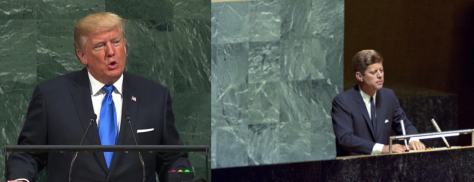
On September 19, 2017, President of the United States Donald J. Trump addressed the United Nations General Assembly. In his speech, he warned of the coming foreign policy changes his administration would bring to the international stage. The fiery rhetoric used by President Trump was reminiscent of that used by President Kennedy to warn of the potential of other nations to subvert the interests and security of the United States.
President Trump gave his speech with the assumption that other nations and terrorist groups fight, not to see their own philosophies realized, but to undermine the wellbeing of the American people. This notion of the president’s that the United States is resented by other countries is as old as the United Nations, itself. Since the end of World War II, language calling for the containment of contrarian beliefs has been used in hundreds of Cold War and post-9/11 speeches. These 2017 remarks are no exception as President Trump warned of “growing dangers that threaten everything we cherish and value.” Similar rhetoric was used by President John F. Kennedy in his own address to the United Nations in 1961 in which he, too warned of “the threats against the vital interests and the deep commitments” of the United States.
Both presidents evoked pathos in their speeches to urge the international community to stand united against the use of nuclear weapons. President Trump said, “North Korea’s reckless pursuit of nuclear weapons and ballistic missiles threatens the entire world with unthinkable loss of human life,” just as President Kennedy reminded the community that “mankind must put an end to war–or war will put an end to mankind.” They explicitly called out the use of terror tactics employed by states and non-state actors, alike, and promised to match any threat with an appropriate reaction. Just as Kennedy vowed that “free men cannot be frightened by threats, and that aggression would meet its own response,” Trump urged the body to “confront together those who threaten us with chaos, turmoil, and terror.” In comparing these two historic speeches, it is evident that much of the rhetoric of the Cold War lives on in today’s political leaders and has a heavy hand in modern diplomatic campaigns.
Photo Credits to the United Nations and the British Broadcasting Corporation


It is interesting to compare the speaking tactics used by President Kennedy and President Trump. You are right in that both leaders call for protection of American values against a dangerous and foreign “Other.” The rhetorical strategy is generally similar, but Trump more calls for defense against outsiders who want to attack the US, and Kennedy advocates for a more global protection of liberty and freedom. Either way, each tactic draws Americans closer together in an effort against the enemy.
LikeLike